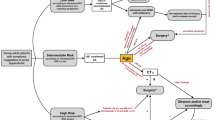Abstract
Background
The role of laparoscopy in the setting of perforated appendicitis remains controversial. A retrospective study was conducted to evaluate the early postoperative outcomes of laparoscopic appendectomy (LA) compared to open appendectomy (OA) in patients with perforated appendicitis.
Methods
A total of 1,032 patients required an appendectomy between January 2005 and December 2009. Among these patients, 169 presented with perforated appendicitis. Operation times, length of hospital stay, overall complication rates within 30 days, and surgical site infection (SSI) rates were analyzed.
Results
Out of the 169 evaluated patients, 106 required LA and 63 OA. Although operation times were similar in both groups (92 ± 31 min for LA vs. 98 ± 45 for OA, p = 0.338), length of hospital stay was shorter in the LA group (6.9 ± 3.8 days vs. 11.5 ± 9.2, p < 0.001). Overall complication rates were significantly lower in the LA group (32.1 vs. 52.4 %, p < 0.001), as were incisional SSI (1.9 vs. 22.2 %, p < 0.001). Organ/space SSI rates were similar in both groups (23.6 % after LA vs. 20.6 % after OA, p = 0.657).
Conclusions
For perforated appendicitis, LA results in a significantly shorter hospital stay, fewer overall postoperative complications, and fewer wound infections compared to OA. Organ/space SSI rates were similar for both procedures. LA provides a safe option for treating patients with perforated appendicitis.
Similar content being viewed by others
References
Addiss DG, Shaffer N, Fowler BS, Tauxe RV (1990) The epidemiology of appendicitis and appendectomy in the United States. Am J Epidemiol 132:910–925
Wei B, Qi CL, Chen TF, Zheng ZH, Huang JL, Hu BG, Wei HB (2011) Laparoscopic versus open appendectomy for acute appendicitis: a metaanalysis. Surg Endosc 25:1199–1208
Li X, Zhang J, Sang L, Zhang W, Chu Z, Li X, Liu Y (2010) Laparoscopic versus conventional appendectomy—a meta-analysis of randomized controlled trials. BMC Gastroenterol 10:129
Guller U, Hervey S, Purves H, Muhlbaier LH, Peterson ED, Eubanks S, Pietrobon R (2004) Laparoscopic versus open appendectomy. Outcomes comparison based on a large administrative database. Ann Surg 239:43–52
Bennett J, Boddy A, Rhodes M (2007) Choice of approach for appendicectomy: a meta-analysis of open versus laparoscopic appendicectomy. Surg Laparosc Endosc Percutan Tech 17:245–255
Moberg AC, Berndsen F, Palmquist I, Petersson U, Resch T, Montgomery A (2005) Randomized clinical trial of laparoscopic versus open appendicectomy for confirmed appendicitis. Br J Surg 92:298–304
Ignacio RC, Burke R, Spencer D, Bissell C, Dorsainvil C, Lucha PA (2004) Laparoscopic versus open appendectomy: what is the real difference? Results of a prospective randomized double-blinded trial. Surg Endosc 18:334–337
Humes DJ, Simpson J (2006) Acute appendicitis. BMJ 333:530–534
Pokala N, Sadhasivam S, Kiran RP, Parithivel V (2007) Complicated appendicitis—is the laparoscopic approach appropriate? A comparative study with the open approach: outcome in a community hospital setting. Am Surg 73:737–741
Fleming FJ, Kim MJ, Messing S, Gunzler D, Salloum R, Monson JR (2010) Balancing the risk of postoperative surgical infections: a multivariate analysis of factors associated with laparoscopic appendectomy from the NSQIP database. Ann Surg 252:895–900
Ingraham AM, Cohen ME, Bilimoria KY, Pritts TA, Ko CY, Esposito TJ (2010) Comparison of outcomes after laparoscopic versus open appendectomy for acute appendicitis at 222 ACS NSQIP hospitals. Surgery 148:625–635
Kehagias I, Karamanakos SN, Panagiotopoulos S, Panagopoulos K, Kalfarentzos F (2008) Laparoscopic versus open appendectomy: which way to go? World J Gastroenterol 14:4909–4914
Mangram AJ, Horan TC, Pearson ML, Silver LC, Jarvis WR (1999) Guideline for prevention of surgical site infection, 1999. Centers for Disease Control and Prevention (CDC) Hospital Infection Control Practices Advisory Committee. Am J Infect Control 27(2):97–132
Sauerland S, Jaschinski T, Neugebauer EA (2010) Laparoscopic versus open surgery for suspected appendicitis. Cochrane Database Syst Rev (10):CD001546
Krisher SL, Browne A, Dibbins A, Tkacz N, Curci M (2001) Intra-abdominal abscess after laparoscopic appendectomy for perforated appendicitis. Arch Surg 136(4):438–441
Liu S, Siewert B, Raptopoulos V (2002) Factors associated with conversion to laparotomy in patients undergoing laparoscopic appendectomy. J Am Coll Surg 194:298–305
Cariati A, Brignole E, Tonelli E, Filippi M, Guasone F, De Negri A, Novello L, Risso C, Noceti A, Giberto M, Giua R (2001) Laparoscopic or open appendectomy. Critical review of the literature and personal experience. G Chir 22:353–357
Fukami Y, Hasegawa H, Sakamoto E, Komatsu S, Hiromatsu T (2007) Value of laparoscopic appendectomy in perforated appendicitis. World J Surg 31:93–97
Lin HF, Wu JM, Tseng LM, Chen KH, Huang SH, Lai IR (2006) Laparoscopic versus open appendectomy for perforated appendicitis. J Gastrointest Surg 10:906–910
Tuggle KR, Ortega G, Bolorunduro OB, Oyetunji TA, Alexander R, Turner PL, Chang DC, Cornwell EE 3rd, Fullum TM (2010) Laparoscopic versus open appendectomy in complicated appendicitis: a review of the NSQIP database. J Surg Res 163:225–228
Stöltzing H, Thon K (2000) Perforated appendicitis: is laparoscopic operation advisable? Dig Surg 17:610–616
Blomqvist PG, Andersson RE, Granath F, Lambe MP, Ekbom AR (2001) Mortality after appendectomy in Sweden, 1987–1996. Ann Surg 233:455–460
Margenthaler JA, Longo WE, Virgo KS, Johnson FE, Oprian CA, Henderson WG, Daley J, Khuri SF (2003) Risk factors for adverse outcomes after the surgical treatment of appendicitis in adults. Ann Surg 238:59–66
Chung RS, Rowland DY, Li P, Diaz J (1999) A meta-analysis of randomized controlled trials of laparoscopic versus conventional appendectomy. Am J Surg 177:250–256
Katkhouda N, Mason RJ, Towfigh S, Gevorgyan A, Essani R (2005) Laparoscopic versus open appendectomy: a prospective randomized double-blind study. Ann Surg 242:439–448
Disclosures
Raffaele Galli, Vanessa Banz, Hartwig Fenner, and Juerg Metzger have no conflicts of interest or financial ties to disclose.
Author information
Authors and Affiliations
Corresponding author
Rights and permissions
About this article
Cite this article
Galli, R., Banz, V., Fenner, H. et al. Laparoscopic approach in perforated appendicitis: increased incidence of surgical site infection?. Surg Endosc 27, 2928–2933 (2013). https://doi.org/10.1007/s00464-013-2858-y
Received:
Accepted:
Published:
Issue Date:
DOI: https://doi.org/10.1007/s00464-013-2858-y




